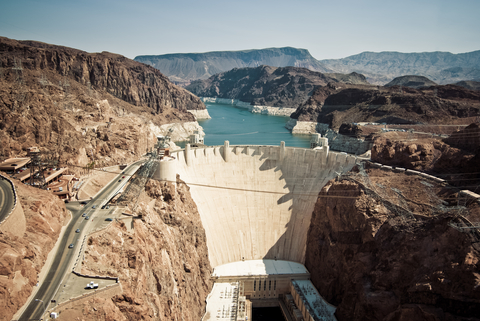Big Damn Dam!

Just about everyone is familiar with Hoover Dam on some level, but in considering it from the perspective of watershapers whose working lives depend on containing and controlling water with concrete structures, I’ve always thought this engineering marvel is worthy of more-than-casual study.
Forgive me if the following is too familiar. Hoover Dam is an arch-gravity barrier on the Colorado River at the border between Arizona and Nevada. Although it was commissioned by Congress in 1928, it was not built until the heart of the Great Depression, when it provided a living to thousands of workers. Unfortunately, more than 100 of those workers gave their lives to the cause in a variety of job-site accidents.
Where it gets interesting is in the ways the project put concrete technology to the test. While curing, concrete heats and contracts, presenting the engineers with a need to break the process down into successions of steps as the project moved along.
According to Wikipedia, “[T]he ground where the dam was to rise was marked with rectangles, and concrete blocks in columns were poured, some as large as 50 feet (15 m) square and 5 feet (1.5 m) high. Each five-foot form contained a series of 1 inch (25 mm) steel pipes through which first cool river water, then ice-cold water from a refrigeration plant was run. Once an individual block had cured and had stopped contracting, the pipes were filled with grout. Grout was also used to fill the hairline spaces between columns, which were grooved to increase the strength of the joins.â€
There was no nearby batch plant, so the concrete was delivered by railroad cars and conveyed to the point of application in huge buckets suspended on a network of cables. The buckets held eight cubic yards of material and were moved to precise pouring locations as needed. (Each bucket only deepened the pour by about an inch, so rumors of bodies being buried in the dam are just that.)
More than 3.25-million cubic yards later, the dam was done and the builders began working on the hydroelectric plant and the waterworks.
Cool fact #1: The concrete could have been used instead to pave a two-lane road from San Francisco to New York (courtesy of Wikipedia, as are the following). Cool fact #2: Concrete cores removed in 1995 indicate that the concrete is continuing to gain strength. Cool fact #3: As luck would have it, the builders used a nonreactive stone aggregate, so the dam has never been subject to alkali-silica reactivity that would make the concrete deteriorate.
I’ve visited the dam several times through the years and have always found it to be both awe-inspiring and remarkably beautiful. The next time you’re in Las Vegas, why not take a side trip to see one of the wonders of modern design?
Video: This 30-minute gem is from the 1950s. It is charming in many ways, filled with interesting reflections of attitudes of the time including the “Please Watch Your Step†sign above a vast (unfenced) abyss. Click here.










